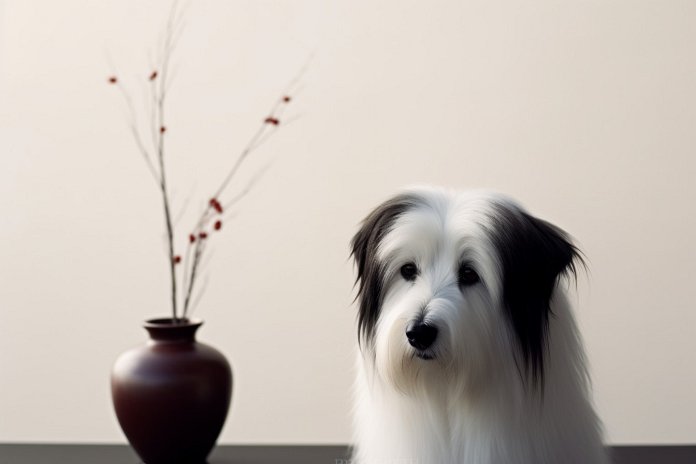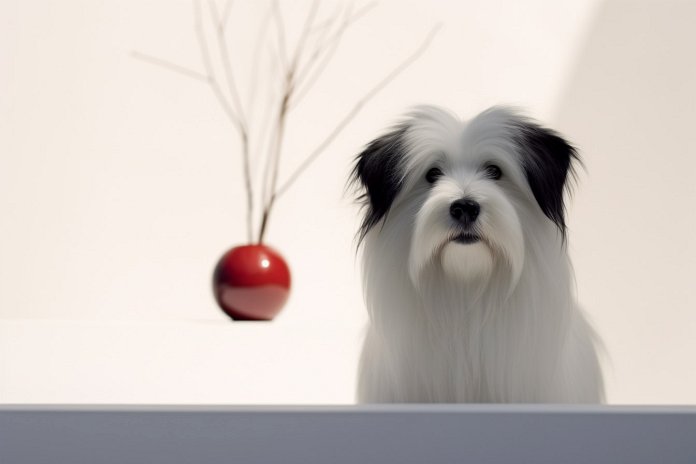
The Coton Eskimo dog is a medium-sized breed that originates from the American Eskimo and Coton de Tulear breeds. These dogs have dense and fluffy coats that are incredibly soft. They come in various colors such as tri-colored, white, black and white, or white with cream. Coton Eskimo dogs are known for their loyalty and make great companions for families. They are friendly and intelligent, making them easy to train. The amount of grooming needed will depend on which parent breed they resemble more closely. For instance, Coton de Tulear’s coat requires trimming, while American Eskimos are easier to maintain but still need regular brushing.
In summary, the Coton Eskimo dog has a beautiful and soft coat that comes in different colors. They are devoted family pets that are friendly and intelligent. The grooming needs of these dogs vary depending on their resemblance to either the Coton de Tulear or American Eskimo parent breed.
Below, we look at Coton Eskimo dog breed, its history, personality, pros and cons of owning an Coton Eskimo, characteristics, and must-see facts. We will also examine how to care for this breed and more. Prepare for a tail-wagging adventure into the world of Coton Eskimos!
| Dog Breed | Coton Eskimo |
| Size | Small |
| Weight | 13-23 lbs (average) |
| Height | 11-18″ (average) |
| Location | United States |
| Ancestry | Coton de Tulear, American Eskimo |
| Date of Origin | Unknown |
| Group | Companion |
| Life Expectancy | 14-16 years |
| Price | $600 – $800 |
| Family | Canidae |
| Scientific Name | Canis Lupus Familiaris |
📖 Breed History
The Coton Eskimo, a mix between the Coton de Tulear and the American Eskimo, has gained popularity in the United States. The origins of the Coton de Tulear, a member of the Bichon family, are not well-documented. It is believed that they descended from dogs that survived a shipwreck near the coast of Madagascar. The Merina, the ruling tribal monarchy in Madagascar during the 17th century, kept them as pets in the royal court. They were brought to France and North America in the 1970s and have since become popular, also known as the “Royal Dog of Madagascar. ” The breed was officially recognized by the AKC in 2014.
American Eskimos, part of the Spitz line, are believed to have originated from Germany. Originally called the American Spitz, the name was changed to American Eskimo to differentiate them from their German lineage. They were known for their attractive appearance and were once performers in circus shows. This breed comes in Toy, Miniature, and Standard sizes. They were registered with the American Kennel Club in 1995. Although not as well-known as other similar-looking breeds, the American Eskimo has a beautiful appearance and is currently ranked as the 122nd most popular breed in the United States.

🐕 Coton Eskimo Appearance
The Coton Eskimo is a medium-sized dog that may weigh up to 25 pounds and has dense, fluffy, and extremely velvety fur. They are either tri-colored, white, white with cream, or white with black. They are likely to resemble their parent breeds, such as the Coton de Tulear with its cotton-like coat or the American Eskimos with their white, fluffy, double-coated fur. The black eyes of this breed are somewhat oval-shaped, and they frequently have tear streaks below the eyes. The alert, acute, and brilliant countenance of an American Eskimo is well-known. The jaw is powerful and has tightly spaced teeth, and the snout is large. They have round paws and carry their tails up over their backs. The Coton de Tulear is distinguished by its wide expressive eyes and strong black snout. Over their backs, their tails curve.
| 👀 Eye Color | Brown |
| 🐽 Nose Color | Black |
| 🐕 Coat Color | White, Pied, Cream |
⚡ Fun Fact: Coton Eskimo dogs need a lot of social interaction. They desire to always be with someone or around people. This breed hates being left alone.
🐶 Traits & Temperament of Coton Eskimo
The Coton Eskimo is a lively and loving companion that is perfect for families. Even for novice pet owners, teaching these bright canines who are eager to please is simple. They make effective watchdogs since they are suspicious of strangers. They probably have some characteristics in common with the parent breeds. For example, American Eskimos get along well with other dogs, are cat-friendly, and are excellent with kids. The Coton de Tulear is a friendly breed that fits in with any environment and gets along well with kids. They are very simple to train because of their high levels of curiosity and desire to please. They are well-known for walking on their hind legs and grunting when playing. To avoid being bored and destructive, your pet will require a lot of activity, but as long as they get outside each day, they are ideal apartment pets.
🤝 Are Coton Eskimos Friendly or Aggressive?
Coton Eskimo dogs are known for being friendly towards other pets, strangers, and children, making them a great choice for families. They are also cat-friendly and get along well with other dogs, making them a good fit for households with multiple pets or those interested in dog meetups. Additionally, Coton Eskimos are often recommended for elderly people, as they are well-suited to provide companionship and support.
This breed is known for being:
- Playful
- Independent
- Energetic
- Protective
- Alert
- Intelligent
- Friendly
- Affectionate
- Lively
- Trainable
- Vocal
🐩 Coton Eskimo Care & Maintenance
Your Coton Eskimo could be hypoallergenic, just like the Coton de Tulear is. However, the American Eskimo is not, thus whether they will be or not depends on which animal your pet most closely resembles. Dogs that are hypoallergenic are beneficial for allergy sufferers. The Coton Eskimo is regarded as minimal maintenance when it comes to grooming. They have a considerable amount of hair loss, so you will need to brush them a few times per week to remove any mats and loose hair. The American Eskimo only need bathing a few times a year, but the Coton de Tulear requires bathing almost every week. The breed, also known as Eskies, has delicate skin, so over-washing them can irritate them and remove their natural oils. You must check your Coton Eskimo’s skin for signs of redness and seek the veterinarian’s guidance on how frequently to bathe your pet.
Coton Eskimo dogs are known to shed more than average due to their natural hair growth cycle. The amount of hair loss they experience is influenced by their health and breed. If you prefer to avoid frequent vacuum cleaning, you may want to think twice before getting a Coton Eskimo puppy. It is also recommended to give them a bath every 3-4 weeks.
🍖 Food: We recommend 3 cups daily, costing you about $1.20 – $1.40 daily, or roughly $34.00 – $45.00 a month.
🐾 Exercise: Coton Eskimo dogs need quite a lot of exercise. Daily walks should be on schedule. If you live an active life, this breed can be a good choice for you.
This dog breed requires to be walked for roughly 9 miles per week, which equates to about 45 minutes of physical activity daily. This consistent moderate exercise regimen will help maintain their physical wellness and significantly contribute to their mental stimulation. Consciously setting aside this time for your furry friend can dramatically enhance their life quality, helping them stay energetic, healthy, and mentally alert.
Did you know: Coton Eskimo dogs have a higher energy level than other dog breeds. If you want a dog for snuggling on the couch, this breed isn’t the perfect choice for you.
❤️🩹 Coton Eskimo Health & Issues
Some of the major concerns for Coton Eskimo Dog Breed can be:
- Progressive Retinal Atrophy
- Hip Dysplasia
While minor concerns include:
- Patellar Luxation
- Legg-Calve-Perthes Disease
- Heart Murmur
🤧 Important: Is Coton Eskimo hypoallergenic? No.
✨ Bonus: Check out cool, creative, and funny names for Coton Eskimo.
⚡ Coton Eskimo Dog Breed Facts
What makes the Coton Eskimo a great choice for families with young children?
The Coton Eskimo is a great choice for families with young children because they are known to be good with children and are very loving and affectionate.
Is the Coton Eskimo breed considered a suitable breed for apartment living?
Yes, the Coton Eskimo breed is considered suitable for apartment living as long as they get daily exercise outside.
How much exercise does a Coton Eskimo require compared to other breeds?
The Coton Eskimo requires a fair bit of exercise compared to other breeds to prevent boredom and destructive behavior.
Is the Coton Eskimo breed known for being good with other pets?
Yes, the Coton Eskimo breed is known for being good with other pets, including dogs and cats.
What are other low-maintenance dog breeds similar to the Coton Eskimo?
Other low-maintenance dog breeds similar to the Coton Eskimo include the Bichon Frise and the Maltese.
What are the common health issues that Coton Eskimos are prone to?
Common health issues that Coton Eskimos are prone to include dental problems, allergies, and joint issues.
Are Coton Eskimos known to be easy to train compared to other breeds?
Yes, Coton Eskimos are known to be easy to train compared to other breeds, especially for first-time pet owners.
Are Coton Eskimos more prone to separation anxiety compared to other breeds?
Coton Eskimos are not particularly prone to separation anxiety compared to other breeds, but individual dogs may vary.
Are there any dog breeds similar to the Coton Eskimo that are suitable for people with allergies?
Dog breeds similar to the Coton Eskimo that are suitable for people with allergies include the Bichon Frise and the Poodle.
What sizes of dogs similar to the Coton Eskimo are best for individuals or families with limited space?
Small-sized dogs similar to the Coton Eskimo, such as the Maltese or the Shih Tzu, are best for individuals or families with limited space.
Is the Coton Eskimo breed known to be good with children with special needs?
The Coton Eskimo breed is known to be good with children, but their compatibility with children with special needs may depend on the individual dog and the specific needs of the child.
How does the grooming and shedding needs of the Coton Eskimo?
The grooming needs of the Coton Eskimo are moderate, as their coat needs regular brushing to prevent matting. They also require occasional trimming. Shedding is minimal.
We use reliable and publicly available data and resources such as AKC and American Canine Registry to ensure that Coton Eskimo dog breed information is accurate and up to date. If you spot an error, please don’t hesitate to bring it to our attention.